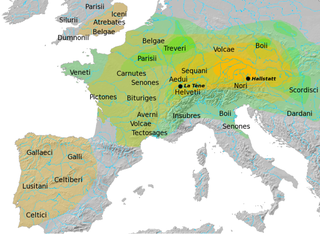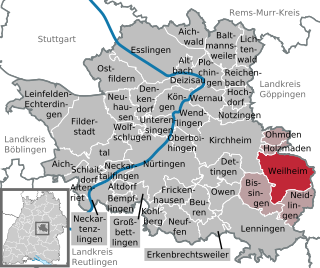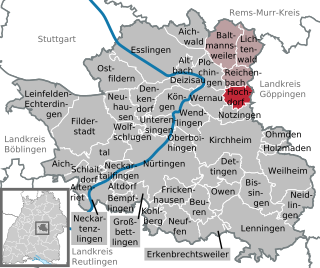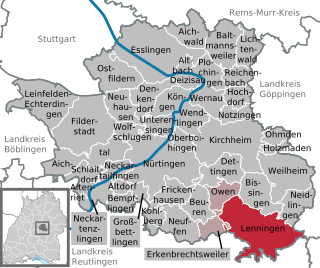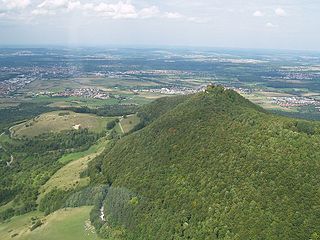| Erkenbrechtsweiler | ||
|---|---|---|
| ||
| Coordinates: 48°33′24″N9°25′56″E / 48.55667°N 9.43222°E Coordinates: 48°33′24″N9°25′56″E / 48.55667°N 9.43222°E | ||
| Country | Germany | |
| State | Baden-Württemberg | |
| Admin. region | Stuttgart | |
| District | Esslingen | |
| Government | ||
| • Mayor | Roman Weiß | |
| Area | ||
| • Total | 6.93 km2 (2.68 sq mi) | |
| Elevation | 702 m (2,303 ft) | |
| Population (2015-12-31) [1] | ||
| • Total | 2,143 | |
| • Density | 310/km2 (800/sq mi) | |
| Time zone | CET/CEST (UTC+1/+2) | |
| Postal codes | 73268 | |
| Dialling codes | 07026 | |
| Vehicle registration | ES | |
| Website | www.erkenbrechtsweiler.de | |

Erkenbrechtsweiler is a municipality in the district of Esslingen in Baden-Württemberg in southern Germany.
Esslingen is a Landkreis (district) in the centre of Baden-Württemberg, Germany. Neighboring districts are Rems-Murr, Göppingen, Reutlingen, Böblingen and the district-free city Stuttgart.

Baden-Württemberg is a state in southwest Germany, east of the Rhine, which forms the border with France. It is Germany’s third-largest state, with an area of 35,751 km2 (13,804 sq mi) and 11 million inhabitants. Baden-Württemberg is a parliamentary republic and partly sovereign, federated state which was formed in 1952 by a merger of the states of Württemberg-Baden, Baden and Württemberg-Hohenzollern. The largest city in Baden-Württemberg is the state capital of Stuttgart, followed by Karlsruhe and Mannheim. Other cities are Freiburg im Breisgau, Heidelberg, Heilbronn, Pforzheim, Reutlingen and Ulm.

Germany, officially the Federal Republic of Germany, is a country in Central and Western Europe, lying between the Baltic and North Seas to the north, and the Alps to the south. It borders Denmark to the north, Poland and the Czech Republic to the east, Austria and Switzerland to the south, France to the southwest, and Luxembourg, Belgium and the Netherlands to the west.
Contents
- Municipality arrangement
- Neighboring communities
- History
- Religions
- Population Development
- Politics
- Council
- Crest
- Economy and Infrastructure
- Transportation
- Education
- Natural monuments
- Sons and daughters of the town
- Personalities who have worked locally
- Literature
- References
It lies within the area of the Celtic Heidengraben.

Heidengraben is the name given to the remains of a large Celtic fortified settlement (oppidum) dating to the Iron Age, located on the plateau of the Swabian Jura in the districts of Reutlingen and Esslingen in Baden-Württemberg, Germany. The settlement was in use from about the late 2nd century BC to the early 1st century BC. By surface area, Heidengraben is the largest oppidum in all of mainland Europe.
Erkenbrechtsweiler is the only municipality in the district of Esslingen, whose denunciation lies fully on the Jura plateau.







